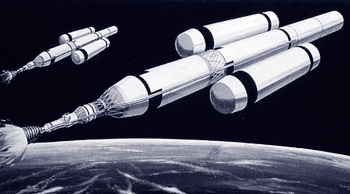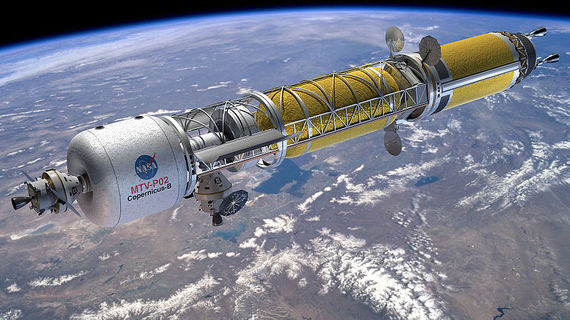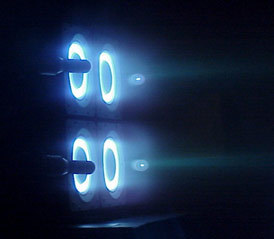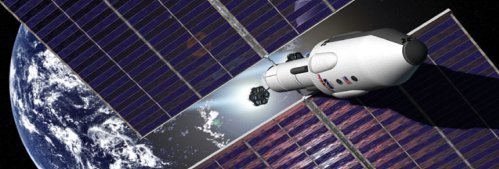The spectacular computer graphics effects and designs of the recent movies Interstellar and The Martian remind us that it is easy to get to Mars and beyond via fantasy technology, but real-world travel is still a hard nut to crack.
In my book Interplanetary Travel: An Astronomer's Guide I made the point that chemical rockets are inefficient and promise only long voyages to the planets and beyond. The most popular trip to Mars takes roughly 250-day each way by Hohman transfer orbit. This 500+ days in space promises grievous challenges for astronaut health and safety. Radiation damage, compromised immune systems and eye damage are only some of the long-term effects of the prolonged contact with microgravity and the space environment made possible by these chemical-rocket-based technologies. As 'rocket scientists' measure efficiency, the specific impulse (SI) of chemical rockets is between SI=200 and 400 seconds, with exhaust speeds of 4 km/sec.
But NASA engineers are not stupid. They have known for decades that the best way to get anywhere is by using some form of ion or nuclear-thermal engine technology. Ion engines use kilowatts of power to accelerate heavy ions like xenon out the back of the rocket at speeds of tens to hundreds of km/sec for specific impulses of SI=2000 to 10,000 seconds. Fusion-based engines pass hydrogen gas through a fission reactor that heats the gas to 5,000 C or more, for exhaust speeds of hundreds to thousands of km per sec, and efficiencies much higher than SI=10,000 seconds. The bottom line is that the higher your efficiency, the less exhaust mass you need to take with you to push your ship to higher speeds. It also means the faster you can get to your destination.
The Past
In designing a Mars mission we have been here before. As I pointed out in my blog "When NASA Had Nuclear Rockets," the NERVA NRX/EST nuclear engine in 1966 ran for two continuous hours. The NERVA-XE engine tests ran for 115 minutes and as a result, it demonstrated that nuclear engines were now almost flight-ready as a technology. The nuclear engine program had demonstrated thrusts as high as 250,000 pounds, 90 minutes of continuous and controllable thrust delivery, and thermal power equal to 4,500 megawatts.
A conceptual illustration of a spacecraft for a manned Mars mission proposed by NASA's Wernher von Braun in August 1969. Two spacecraft would make the trip in tandem, each one powered by three NERVA-type engines. (Image courtesy: NASA).
Werner von Braun then hatched a post-Apollo plan to use a NERVA engine as the third stage of the Saturn V rocket and plausibly get to Mars by 1978 and even use this engine as the work-horse to establish a large lunar colony by 1981. The Space Nuclear Propulsion Office planned to build ten nuclear engine-based vehicles, six for ground tests and four for flight tests, but the development program was delayed after 1966 as NERVA became a political hot-potato in the debate over a Mars mission. The nuclear-enhanced Saturn V would carry two to three times more payload into space than the chemical version, enough to easily loft 340,000 pound space stations and replenish orbital propellant depots. Ultimately the NERVA program became so closely linked to plans to go to Mars, that when Congress finally balked at the expense and folly of going to Mars, the NERVA program no longer had a "customer" to serve. The NERVA program was finally terminated altogether on January 5, 1973.
 Artist's rendering of the proposed Mars Transfer Vehicle (MTV) "Copernicus" that would incorporate NTR propulsion and inflatable habitat technology. A five-meter-diameter crewed Orion MPCV is docked on the far left. (Credit: NASA)
Artist's rendering of the proposed Mars Transfer Vehicle (MTV) "Copernicus" that would incorporate NTR propulsion and inflatable habitat technology. A five-meter-diameter crewed Orion MPCV is docked on the far left. (Credit: NASA)
NASA originally investigated using a nuclear propulsion system in its baseline plan in the Design Reference Mission for getting to Mars in the 2030s. Called Copernicus, it would be assembled in space and be the transfer vehicle for supplies and crews to and from mars, though never touching down on the planet. Although the system was in the plans as of 2013, Copernicus has now been sidelined in favor of the cheaper and more politically acceptable solar-electric system.
The Present.
Although fission-based engine technology seems dead in the water, ion engine technology is so environmentally benign, efficient and potentially very fast that there is positively (sorry!) a love fest going on to develop it. The principle is simple. In fact, the old TV 'picture tube' is a good analog. You take a bunch of charged particles, in this case electrons, and you accelerate them in a high-voltage so that they have speeds of thousands of kilometers/sec. But instead of letting them crash into a phosphor screen, you just let them continue on into space. If you replace the electrons with xenon ions that are 240,000 times as massive, presto-chango, you have a primitive ion engine.
 Hall Effect thrusters being tested by Busek Systems produce 1 Newton of thrust for 20,000 watts of power. In principle, hundreds of these can be combined to develop much higher thrust if enough power is available.
Hall Effect thrusters being tested by Busek Systems produce 1 Newton of thrust for 20,000 watts of power. In principle, hundreds of these can be combined to develop much higher thrust if enough power is available.
NASA's Dawn and Deep Space 1 spacecraft used xenon-based, 2-kilowatt NSTAR ion engines only delivered about 0.09 Newtons (1/3 ounce) of thrust with an SI of 3100 seconds, but after a year of constant operation (not possible with chemical rockets) they boosted their spacecraft by several km/sec in speed; enough to reach several asteroids and comets!
The main thing that limits ion engines today is the applied power. They have to use kilowatts of electrical power to create less than an ounce of thrust. For interplanetary transport of heavy payloads in the shortest times, we want dozens and even hundreds of Newtons of thrust, and this requires power plants in the 200,000 to 1 million watt range!
 This low-thrust spaceship (an artist's concept) is propelled by an ion engine and powered by solar electricity. Eventually the craft will pick up speed -- a result of relentless acceleration -- and race along at many miles per second. Image credit: John Frassanito & Associates, Inc.
This low-thrust spaceship (an artist's concept) is propelled by an ion engine and powered by solar electricity. Eventually the craft will pick up speed -- a result of relentless acceleration -- and race along at many miles per second. Image credit: John Frassanito & Associates, Inc.
NASA's current solar-electric propulsion plan is to use a solar cell-based power plant to drive a Hall Effect-based ion engine in the 50,000 to 100,000 watt range. Another possibility that may soon be tested onboard the international space station is the Variable Specific Impulse Magnetoplasma Rocket (VASIMR). The VX-200 engine with an SI=5000 seconds will use 200,000 watts of electrical power to develop 5 Newtons (18 ounces) of thrust for many hours. Although the flight model called VX-200-1 was canceled in March 2015, NASA is still intrigued by using this technology in other applications such as spacecraft and space tugs. According to Ad Astra who develops VASIMR engines, a trip to Mars could take as little as 39 days, but as critics like Dr. Robert Zubrin have pointed out, this is only if a source of power in the near-megawatt range can be developed.
Artist view of Ad Astra VASIMR engines installed on the ISS (Credit:AdAstra/NASA)
The main drawback is the power needed calls for either a nuclear reactor system, not favored for many reasons, or an elaborate array of solar panels. Currently, space-qualified solar cell technology is not able to reach the required power levels without having to deploy panels that are nearly ten times the size of the international space station (2500 square-meters and 120 kilowatts), although promising thin-film photovoltaic arrays are now under development, which promise 1000 watts per kilogram. Solar arrays producing 300 W/kg from the sun's 1366 W/m² '1X' power near the Earth are already available. By using Fresnel lens 10X sunlight concentrators, Entech Solar has developed even larger, low mass systems eventually suitable for high-power space applications.
The Future.
Most NASA-watchers are convinced that the Mars Transfer Vehicle will be solar-electric, and based on ion engine designs, with high-efficiency solar panels making the craft look like the old-style umbrella-shaped solar wind-propulsion systems, or a version of the international space station on steroids. The system will be able to get to Mars in about 100 days or so. What is even more cool is that these improvements in solar panel efficiency will let you run your entire house on a few meters-square of installed solar panels; not your entire roof covered. So long before it launches, the Mars mission will already return advancements for Green Technology here on Earth for billions of people to use.
Once we get to Mars in 100 days, the commercial race will be on to get there in a week or less, and that will open up the entire solar system to journeys of discovery, commerce and yes of course, entertainment. If you can get to Mars in a five-day work week, you can get to Saturn in a couple of months!
Now, wouldn't that be cool?